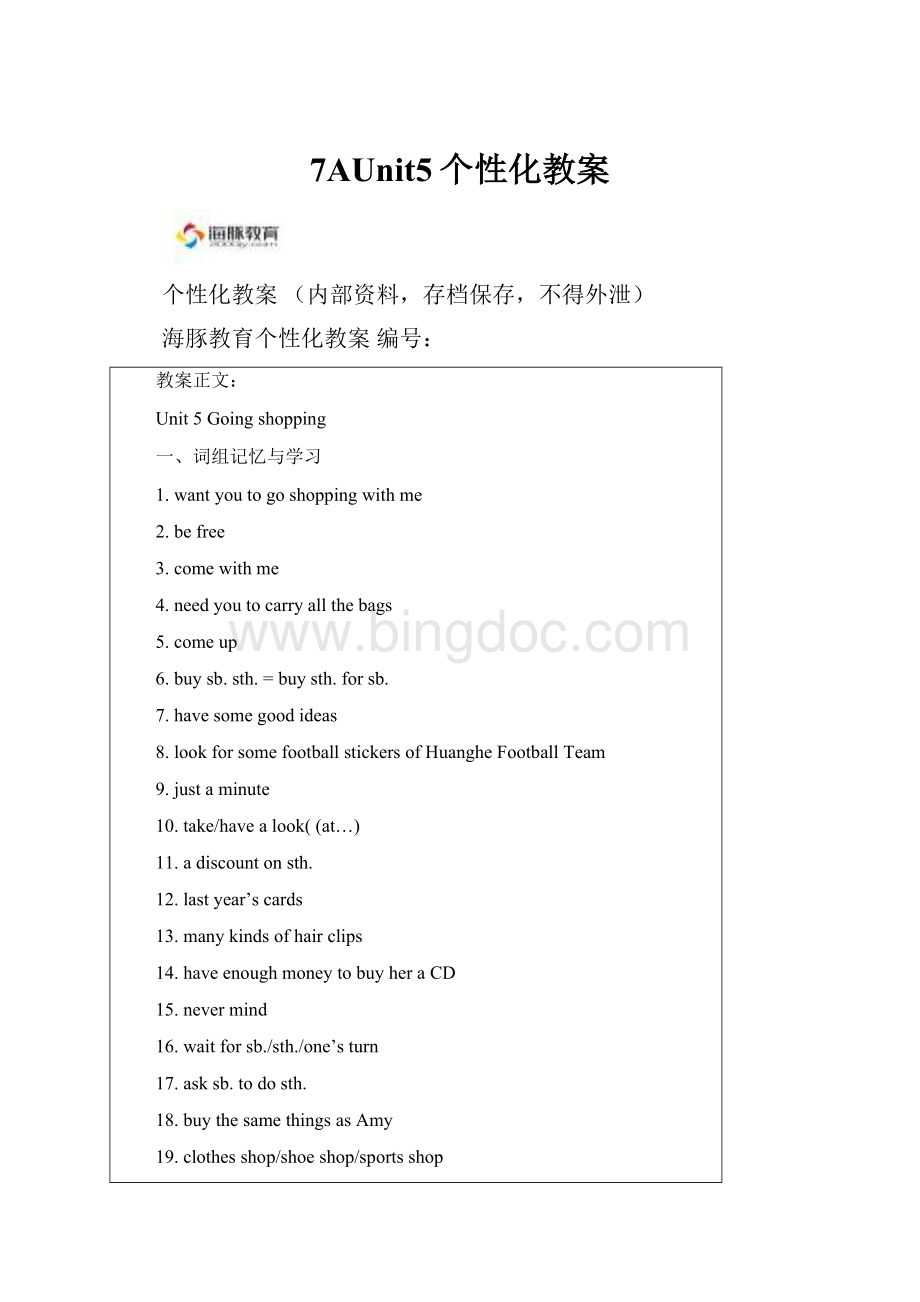7AUnit5个性化教案.docx
《7AUnit5个性化教案.docx》由会员分享,可在线阅读,更多相关《7AUnit5个性化教案.docx(12页珍藏版)》请在冰点文库上搜索。

7AUnit5个性化教案
个性化教案(内部资料,存档保存,不得外泄)
海豚教育个性化教案编号:
教案正文:
Unit5Goingshopping
一、词组记忆与学习
1.wantyoutogoshoppingwithme
2.befree
3.comewithme
4.needyoutocarryallthebags
5.comeup
6.buysb.sth.=buysth.forsb.
7.havesomegoodideas
8.lookforsomefootballstickersofHuangheFootballTeam
9.justaminute
10.take/havealook((at…)
11.adiscountonsth.
12.lastyear’scards
13.manykindsofhairclips
14.haveenoughmoneytobuyheraCD
15.nevermind
16.waitforsb./sth./one’sturn
17.asksb.todosth.
18.buythesamethingsasAmy
19.clothesshop/shoeshop/sportsshop
20.writealettertosb.
21.membersoftheschoolbasketballteam
22.invitesb.to(cometo)one’sbirthdayparty
23.atthemoment
24.visitsb./sp.
25.payforhernewshoes
26.stayouttoolate
27.makewishes
28.childreninpoorareas
29.collectwritingpaper
30.raisemoneyforsb.
31.apairoffootballboots
32.onthetopfloor
33.tryon
34.agoodplacetomeetfriends
35.standoutsideatoyshop
36.call100forhelp
37.matchherT-shirtverywell
38.differentkindsofbooks
39.callsb.on
40.donatemoneytosb.
41.needsomemoreshops
42.areallyfunplacetogo
43.foodfromdifferentcountries
44.lookforhermother
二、句子研究与分析
1.Ineedyoutocarryallthebags.
needsb.todosth.意为“需要某人做某事”
needsth.意为“需要某物”,needtodosth.意为“需要做某事”
2.Whatareyoulookingfor?
lookfor表示trytofind,强调动作;而find则表示已经找到,着重结果。
3.Howmuchdothecardscost?
sth.cost(s)sb.somemoney
sb.spend(s)somemoneyonsth.
sb.pay(s)somemoneyforsth.
e.g.Thebikecostsme500yuan.
Ispend500yuanonthebike.
Ipay500yuanforthebike.
cost的主语通常是物,而pay和spend的主语通常是人。
4.Ithinkyoucanbuyhimafootball.
buysb.sth.=buysth.forsb.和动词buy的用法类似的动词还有make,get,sing等。
5.TheymatchherfavouriteT-shirt.
matchsth.表示“与某物(颜色、形状或图案)相同或匹配”,相当于gowellwith.
e.g.Thepicturematchesthestorywell.=Thepicturegoeswellwiththestory.
6.Idon’thaveenoughmoney.
haveenough+名词+todosth.表示“有足够的……做某事”,enough要放在所修饰名词的前面。
enough作为副词修饰形容词或副词时,通常要后置。
e.g.Theyhaveenoughtimetofinishtheirhomework.
Heisoldenoughtogotoschool.
7.Nevermind.
8.Areyoustudyingatthemoment?
atthemoment意为“此刻”,用作时间状语。
9.CouldItrythemon,please?
tryon意为“试穿”,与名词连用时,该名词可放在tryon之后或之间,但与代词连用时,该代词只能放在tryon之间。
10.Well,theyfitverywell.
fit意为“(鞋子)合脚,(衣服)合身”,可以坐及物动词和不及物动词。
三、语法理解与归纳
一般现在时、现在进行时、一般将来时
一般现在时
1定义:
表示通常性、规律性、习惯性的状态或者动作(有时间规律发生的事件)的一种时间状态。
2基本结构
A.如果谓语动词是实义动词的结构
结构:
肯定式:
主语+动词原形/动词的第三人称单数
否定式:
主语+助动词don't/doesn't+动词原形+其他
疑问式:
Do/Does+主语+动词原形+其他
简略回答:
(肯)Yes,主语+do/does(否)No,主语+do/doesnot
缩写形式:
don't==donotdoesn't==doesnot
注意:
have的第三人称单数为has
疑问句型
谓语动词是实义动词,方法是在主语前加助动词do或does构成,句中动词要改用原型动词。
do用于第一人称和名词复数,does用于第三人称单数和名词单数或不可数名词。
Doyouknowit?
Yes,Ido./No,Idon't.
Doesshehaveapen?
Yes,shedoes./No,shehasn't.[have这里是实义动词]
Dotheyplaybasketballafterschool?
Yes,theydo./No,theydon't.
否定句型
谓语动词是实义动词,是在谓语动词前加donot或doesnot,谓语动词改用动词原型。
Idon'thaveluchathome.Mr.Jimmydoesn'tknowFrench.
Theydon'tplaybasketballonthesportsground.
肯定式
疑问式
否定式
否定疑问式
Iwork.
DoIwork?
Idonotwork.
DoInotwork?
Youwork.
Doyouwork?
Youdonotwork.
Doyounotwork?
Wework.
Dowework?
Wedonotwork.
Dowenotwork?
Theywork.
Dotheywork?
Theydonotwork.
Dotheynotwork?
He(She,It)works.
Doeshe(she,it)work?
He(She,It)doesnotwork.
Doeshe(she,it)notwork?
B如果谓语动词是be/情态动词的结构
结构:
主语+be+其他主语+情态动词+动词原形
1)be动词的第一人称单数为am,第三人称单数为is,其他人称为are
Be动词顺口溜用法:
我用am,你用are,is用于他,她,它,单数is,复数are.
肯定式:
主语+am/is/are+其他
否定式:
主语+am/is/are+not+其他
疑问式:
Am/Is/Are+主语+其他?
简略回答:
(肯)Yes,主语+am/is/are(否)No,主语+am/is/arenot
缩写形式:
I'm==IamThat's==ThatisWe're==WeareWhat's==WhatisYou're==YouareWho's==WhoisThey're==TheyareWhere's==WhereisHe's==HeisShe's=SheisIt's==Itisisn't==isnotaren't==arenot
疑问句型
1.对于谓语动词或助动词是be、can/may等,将这些词移到主语前面。
Areyoustudents?
Yes,weare./No,wearen't.
IsJaneintheclassroom?
Yes,heis./No,heisn't.
Isthereanywaterintheglass?
Yes,thereis./No,thereisn't.
Canyouswim?
Yes,Ican./No,Ican't.
否定句型
谓语动词或助动词是be、can/may/等,在将助动词后加not.
Iamnotatcollege.Mr.Wangisn't50yearsold.Youmaynotgonow.
2)情态动词can/may的用法同be动词Eg:
Icandomyhomework.Shecanseeapicture.
3.动词的表达方法
主要通过谓语动词的变化和用时间词语来表示,其中最主要的是谓语动词的变化。
现在一般时动词变化的规则是:
A实义动词
1.如果主语是名词复数和第一人称I、we,谓语动词不用做任何变化,即仍然用动词原型表示:
Weusuallygotoschoolat7:
30.我们通常7:
30上学去。
[go]
Myparentsgivetenyuantomysistereveryweek.我父母每星期给我妹妹十元钱。
[give]
2.主语是任何一个单数名词或者是第三人称单数,谓语动词要进行必要的变化。
特别提一点:
不可数名词也算作单数处理。
情况
构成方法
读音
例词
一般情况
加-s
清辅音后读/s/浊辅音和元音后读/z/
swim-swims;help-helps;
以s,sh,ch,x,o等结尾的词
加-es
读/iz/
Passes,finishes,teaches,goes
以辅音字母+y结尾的词
变y为i再加es
读/z/
study-studies
实义动词单数变法规则:
写出下列动词的第三人称单数:
studyplaygocomehelpteachlielistenbeginopensitwashguesscutruneat
B助动词
a.基本助动词be(是)-am,is,are
I用am;she/he/it,名词单数都用is;we,you,they,名词复数都用are
b.基本助动词have(有)-have,has
I,we,you,they,名词复数都用have;she/he/itis,名词单数都用has
c.基本助动词do-dodoes
I,we,you,they,名词复数都用do;she/he/itis,名词单数都用does
d.情态助动词,不论单复数、不论什么人称都没有变化,都用can,may等。
而且,句子中有了助动词,谓语动词就不需要有任何变化了,即用动词原形表示。
Lucyisathomenow.露茜现在在家。
Wehavesixclasseseveryday.我们每天上六节课。
JacklikesChinesefoodverymuch.杰克很喜欢中国饮食。
Wecanseesomepicturesonthewall.我们能看到墙上的画。
4具体运用
1.表示经常的或习惯性的动作,常与表示频率的时间状语连用。
一般现在时的时间状语有:
usually,often(经常),always(总是),sometimes(有时),onSundays/Mondays,today,everyday(week,month,year,…),thisyear,onceaweek(month,year,…)一周(月,年)一次
everymorning/night/evening/day/week,fromtimetotime,twiceaweek'
注意:
行为动词的一般现在时中涉及了频度副词,用法:
常见的频度副词有:
often,always ,usually ,never ,sometimes等用于行为动词之前,be/助、情态动词之后.
e.g.Ileavehomeforschoolat7:
00everymorning. Idon'tusuallygetupat6o’clock.Heoftengoestoschoolbybike.
2.表示客观事实和普遍真理。
e.gShanghailiesintheeastofChina. Twoandtwoarefour.二加二等于四。
Theearthmovesaroundthesun.地球绕着太阳转。
4.表示主语现在具备的性格、能力、特征和状态。
e.g.Helikes Englishverymuch.他非常喜欢英语。
Sheisastudent.TomcanspeakEnglish.
现在进行时
1.定义:
表示现在或现阶段正在进行的动作。
常与now,thesedays等时间状语连用,句首有Look!
/Listen!
等提示语。
I’mvisitingmyfriendsnow.Look!
Heissittingthere.
2.基本结构:
be动词(am,is,are)+动词的现在分词构成(动词-ing)
肯定句:
be+doing否定句:
be+notdoing
一般疑问句:
Be动词提前到句子开头+主语+doing
记忆口诀:
现在进行主动宾,be+动词-ing要记清;助动词(am,is,are)跟着主语变,am,is,are+-ing;
变疑问,助动词(am,is,are)后主语跟,变否定,助动词(am,is,are)后not跟。
例句:
肯定句:
Iamworking.Heisworking.Theyareworking.
否定句:
Iamnotworking.Heisnotworking.Theyarenotworking.
疑问句:
Areyouworking?
Isheworking?
Aretheyworking?
回答:
Yes,Iam.Yes,heis.Yes,theyare.
No,I’mnot.No,heisn’t.No,theyaren’t.
注意:
现在进行时的特殊用法:
1)现在进行时与always连用时,往往含有赞扬、厌恶、责备等感情色彩。
如:
Heisalwaysworkinghard.他总是非常努力地工作。
(表示赞扬)
2)come,go,begin,start,leave等动词常用现在进行时表示将要发生的动作。
SheisleavingChinatomorrow.I'mgoingtoschool.
3.现在分词的变法规则:
当我们说某人正在做什么事时,动词要使用分词形式,不能用原形,构成如下:
一)一般在后加ing。
如:
sing-singing,see-seeing,play-playing,go-going,do-doing,
二)以不发音e的结尾的去掉e再加ing。
如:
write-writing,have-having,come–coming来;close-closing关;make–making制造ride–riding骑;write-writing写;take-taking拿走;have–having有;
三)以重读闭音节结尾且一个元音字母+一个辅音字母(注意除开字母组合如show–showing,draw-drawing)要双写最后的辅音字母再加ing。
如:
put-putting,run-running,get-getting,let-letting,begin-beginning;sit-sitting;cut–cutting切;shop-shopping购物;begin-beginning开始forget-forgetting忘记;stop-stopping停止travel-travelling旅行;begin—beginning开始;swim—swimming游泳;run—running跑步;put—putting放;let—letting让;get—getting得到
四)以ie结尾的变ie为y再加ing。
如:
tie-tying系die-dying死lie-lying位于
一般将来时
1.意义:
表示将来某个时间要发生的动作或存在的状态常与表示将来的时间状语连用。
如:
tomorrow,soon,nextMonday,nextyear,nextweekend,thisafternoon,thisevening,inamonth…
二.构成及变化
一般将来时常用的两种结构
1.begoingto+动词原形:
表示打算、准备做的事或有迹象即将发生或肯定要发生的事。
肯定句:
主语+be(am,is,are)goingto+动词原形+其它成份。
否定句:
主语+be(am,is,are)not+goingto+动词原形+其它成份
Iamnotgoingto(goto)thecinematonight.我今天晚上不打算去看电影。
一般疑问句:
Be(am/is/are)+主语+goingto+动词原型+其它成份…?
Isyourfathergoingtoplaybasketballwithyou?
No,heisn’t.
特殊疑问句:
特殊疑问词(Wh-)+一般疑问句?
WhereareyougoingtospendSpringFesital.?
春节你打算在哪过?
2.will+动词原形:
表示将要发生的动作或情况,没有太多的计划性,还用来表示意愿。
肯定句:
主语+will+动词原形+其它成份
否定句 :
主语+will+not+动词原形+其它成份
一般疑问句:
Will+主语+动词原形+其它成份
简略回答:
(肯)Yes,主语+will.(否)No,主语+will+not
缩写形式:
'll==willwon't==willnot
shewillwritetohimnextweek.下周我将给他写信。
Theywon’twatchTVthisevening.今天晚上他们不看电视。
Willyoustayathomewithustomorrow?
Yes,Iwill.No,Iwon't.
注意:
1.will表示的一般将来时,本身没有人称和数的变化,用法同情态动词。
如果要表达“将来不会……”,就要用其否定形式,可以在will后直接加not,构成willnot或缩写为won’t.其疑问形式,将will提到句首即可。
2..区分这两结构:
都表将来。
但是begoingto+动词原形可以表示有迹象要发生的事
Lookatthedarkclouds,itisgoingtoberain.
“will”句型与“begoingto”句型,前者表示纯粹将来,后者表示打算、计划、准备做的事情,更强调主语的主观意愿。
例如:
TomorrowwillbeSaturday.明天是周六了。
WearegoingtovisitParisthissummer.今年夏天我们打算游览巴黎。
3.begoingto结构后面习惯上不跟go,come等表位移的动词,一般用该动词的进行时形式表示。
如:
He’sgoingtoNewYorknextweek.下周他要去纽约.
SheiscomingBeijingtomorrow.
习题精选
一、选择题
1._____youhaveabook?
ADoB.AreC.IsD.Have
2.DoesLiLeiliketowatchTV?
______________.
A.Yes,helike.B.No,hedoesn’t.C.Yes,he’dlike.D.No,helikes.
3.Shedoesn’t______herhomeworkintheafternoon.
A.doingB.todoC.doesD.do
4.How____Mr.Smith______toEngland?
A.do,goB.is,goC.does,goD.does,goes
5._____she______homeatsixeveryday?
A.Is,leaveB.Does,leaveC.Is,leavesD.D